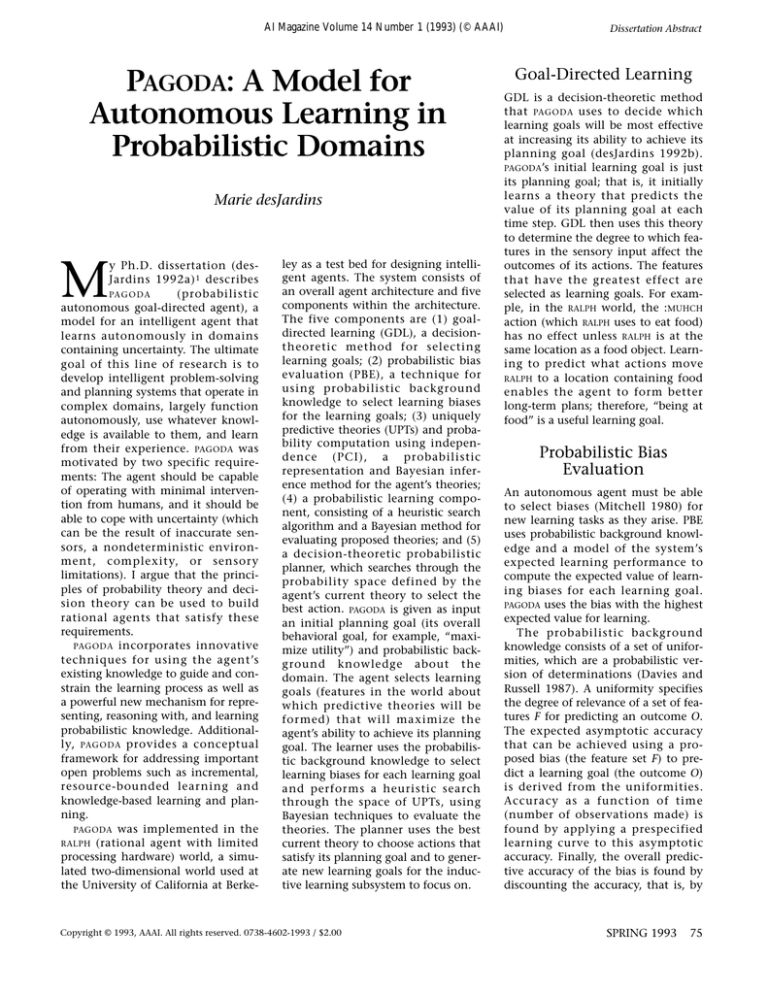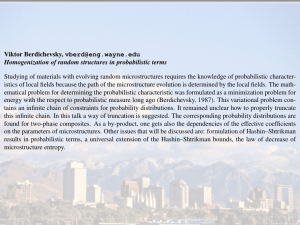
AI Magazine Volume 14 Number 1 (1993) (© AAAI)
PAGODA: A Model for
Autonomous Learning in
Probabilistic Domains
Marie desJardins
M
y Ph.D. dissertation (desJardins 1992a) 1 describes
PA G O D A
(probabilistic
autonomous goal-directed agent), a
model for an intelligent agent that
learns autonomously in domains
containing uncertainty. The ultimate
goal of this line of research is to
develop intelligent problem-solving
and planning systems that operate in
complex domains, largely function
autonomously, use whatever knowledge is available to them, and learn
from their experience. PAGODA was
motivated by two specific requirements: The agent should be capable
of operating with minimal intervention from humans, and it should be
able to cope with uncertainty (which
can be the result of inaccurate sensors, a nondeterministic environment, complexity, or sensor y
limitations). I argue that the principles of probability theory and decision theory can be used to build
rational agents that satisfy these
requirements.
PAGODA incorporates innovative
techniques for using the agent’s
existing knowledge to guide and constrain the learning process as well as
a powerful new mechanism for representing, reasoning with, and learning
probabilistic knowledge. Additionally, PAGODA provides a conceptual
framework for addressing important
open problems such as incremental,
resource-bounded learning and
knowledge-based learning and planning.
PAGODA was implemented in the
RALPH (rational agent with limited
processing hardware) world, a simulated two-dimensional world used at
the University of California at Berke-
ley as a test bed for designing intelligent agents. The system consists of
an overall agent architecture and five
components within the architecture.
The five components are (1) goaldirected learning (GDL), a decisiontheoretic method for selecting
learning goals; (2) probabilistic bias
evaluation (PBE), a technique for
using probabilistic background
knowledge to select learning biases
for the learning goals; (3) uniquely
predictive theories (UPTs) and probability computation using independence (PCI), a probabilistic
representation and Bayesian inference method for the agent’s theories;
(4) a probabilistic learning component, consisting of a heuristic search
algorithm and a Bayesian method for
evaluating proposed theories; and (5)
a decision-theoretic probabilistic
planner, which searches through the
probability space defined by the
agent’s current theory to select the
best action. PAGODA is given as input
an initial planning goal (its overall
behavioral goal, for example, “maximize utility”) and probabilistic background knowledge about the
domain. The agent selects learning
goals (features in the world about
which predictive theories will be
formed) that will maximize the
agent’s ability to achieve its planning
goal. The learner uses the probabilistic background knowledge to select
learning biases for each learning goal
and performs a heuristic search
through the space of UPTs, using
Bayesian techniques to evaluate the
theories. The planner uses the best
current theory to choose actions that
satisfy its planning goal and to generate new learning goals for the inductive learning subsystem to focus on.
Copyright © 1993, AAAI. All rights reserved. 0738-4602-1993 / $2.00
Dissertation Abstract
Goal-Directed Learning
GDL is a decision-theoretic method
that PAGODA uses to decide which
learning goals will be most effective
at increasing its ability to achieve its
planning goal (desJardins 1992b).
PAGODA’s initial learning goal is just
its planning goal; that is, it initially
learns a theory that predicts the
value of its planning goal at each
time step. GDL then uses this theory
to determine the degree to which features in the sensory input affect the
outcomes of its actions. The features
that have the greatest effect are
selected as learning goals. For example, in the RALPH world, the :MUHCH
action (which RALPH uses to eat food)
has no effect unless RALPH is at the
same location as a food object. Learning to predict what actions move
RALPH to a location containing food
enables the agent to form better
long-term plans; therefore, “being at
food” is a useful learning goal.
Probabilistic Bias
Evaluation
An autonomous agent must be able
to select biases (Mitchell 1980) for
new learning tasks as they arise. PBE
uses probabilistic background knowledge and a model of the system’s
expected learning performance to
compute the expected value of learning biases for each learning goal.
PAGODA uses the bias with the highest
expected value for learning.
The probabilistic background
knowledge consists of a set of uniformities, which are a probabilistic version of determinations (Davies and
Russell 1987). A uniformity specifies
the degree of relevance of a set of features F for predicting an outcome O.
The expected asymptotic accuracy
that can be achieved using a proposed bias (the feature set F) to predict a learning goal (the outcome O)
is derived from the uniformities.
Accuracy as a function of time
(number of observations made) is
found by applying a prespecified
learning curve to this asymptotic
accuracy. Finally, the overall predictive accuracy of the bias is found by
discounting the accuracy, that is, by
SPRING 1993
75
Dissertation Abstract
multiplying the accuracy by a discounting function and integrating
over time. The discounting function
models the effect of the passage of
time on the value of predictions. The
resulting expected discounted future
accuracy is used as the expected value
of the bias.
Representing
Probabilistic Theories
PAGODA’s
learned knowledge is represented as probabilistic theories about
its learning goals. Each theory consists of a set of conditional probabilities predicting the value of a learning
goal, or feature of the world. PAGODA’s
theories are called UPTs: Their form is
constrained in such a way that a
straightforward set of independence
assumptions can be applied to the
theory to make a unique probabilistic
prediction about the learning goal
whose value is predicted by the
theory given any input (that is, any
value for the agent’s sensory input
and any action taken by the agent).
The predictions are made by the PCI
inference method. PCI finds the set of
most-specific conditional probabilities
in a theory that apply to a given
input. These probabilities are combined by iteratively finding a separable rule in the set, 2 computing its
contribution to the overall probabilistic prediction using independence
assumptions, and recursively processing the remaining probabilities.
Probabilistic Learning
The learning component utilizes
splitting and merging operations
(similar to those used in C O B W E B
[Fisher 1987]) to search the space of
theories. The learning process is
incremental in that it processes each
training example separately, yielding
a set of best theories after each one;
however, because all past training
instances are stored and potentially
reprocessed, the learning process is
not bounded in time or space. Proposed theories are evaluated using a
Bayesian evaluation function, where
the prior probability of a theory
depends on its simplicity, and its likelihood depends on its predictive
76
AI MAGAZINE
accuracy on the set of training examples seen so far. The simplicity of a
theory is based on the minimum
description length principle (Rissanen 1978) but can vary depending on
the encoding scheme used. In the dissertation, four different encoding
schemes are discussed, corresponding
to four levels of abstraction for classifying theories.
the National Aeronautics and Space
Administration and Lockheed Missiles and Space Company. I am especially grateful to my family for
encouraging and supporting me, particularly my sister Susan, who was
inadvertently omitted from the
acknowledgments section in the original dissertation.
Notes
Probabilistic Planning
PAGODA ’s
planning method is based
on decision theory (von Neumann
and Morgenstern 1947). The planner
performs a random action a fixed percentage of the time (the default is 25
percent) to ensure that the environment is continuously explored and
that the agent does not get stuck on a
local maximum. The rest of the time,
the planner performs a heuristic
search through the space of possible
outcomes (as defined by the agent’s
current best theory) for each action;
this search extends to a fixed depth
(default 3). The maximum expected
utilities in each final state are propagated backward, yielding an expected
utility for each initial action. At each
level, the utility of the action with
the highest expected (average) utility
is used as the value to propagate
back.
Results
was tested in the RALPH world.
The results of these tests show that
PAGODA learns relatively accurate (that
is, significantly better than chance)
probabilistic models of the world and
that using these models allows the
system to improve its overall performance. However, the tests also highlight areas for future research,
particularly improving the heuristic
search for theories and the probabilistic planning mechanism.
PAGODA
Acknowledgments
I would like to thank my adviser,
Stuart Russell; the members of the
RUGS (Russell’s Unusual Group of
Students) research group at UC Berkeley; and innumerable colleagues for
their comments and advice. This
research was partially supported by
1. This article is available as Technical
Report UCB/CSD 92/678 from the Department of Computer Science, University of
California at Berkeley, Berkeley, CA 94720.
2. A rule is separable within a set if its
conditioning context can be split into a
set of features that are shared with no
other rule in the set and another set of
features that are shared with some single
other rule in the set.
References
Davies, T., and Russell, S. 1987. A Logical
Approach to Reasoning by Analogy, Technical Report 385, AI Center, SRI International, Menlo Park, California.
desJardins, M. 1992a. Goal-Directed
Learning: A Decision-Theoretic Model for
Deciding What to Learn Next. Paper presented at the 1992 Machine Discovery
Workshop, Aberdeen, Scotland, 4 July.
desJardins, M. E. 1992b. PAGODA: A Model
for Autonomous Learning in Probabilistic
Domains. Ph.D. diss., Dept. of Computer
Science, Univ. of California at Berkeley.
Fisher, D. H. 1987. Knowledge Acquisition
via Incremental Conceptual Clustering.
Machine Learning 2:139–172.
Mitchell, T. 1980. The Need for Biases in
Learning Generalizations, Technical
Report, CBM-TR-117, Dept. of Computer
Science, Rutgers Univ.
Rissanen, J. 1978. Modeling by Shortest
Data Description. Automatica 14:465–471.
von Neumann, J., and Morgenstern, O.
1947. Theory of Games and Economic
Behavior. Princeton, N.J.: Princeton University Press.
Marie desJardins is a member of the
Applied Artificial Intelligence Program at
SRI International, Menlo Park, California.
She received her Ph.D. in computer science from the University of California at
Berkeley in 1992. Her current interests
include machine learning, planning and
scheduling, temporal reasoning, and intelligent tutoring systems.





